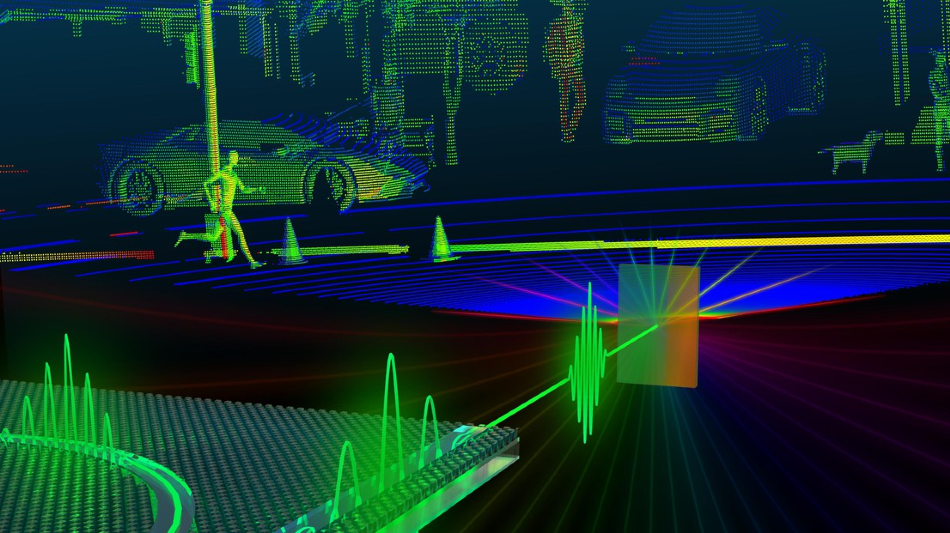May 14 2020
Light detection and ranging (LiDAR) includes a series of methods in which laser light is used to quantify distances by multiplying the time delay between received and transmitted optical signals with the speed of light.
 An illustration of LiDAR waves. Image Credit: Johann Riemensberger.
An illustration of LiDAR waves. Image Credit: Johann Riemensberger.
In advanced 3D LiDAR sensors, high lateral/vertical and radial resolution are integrated and are the essential components in the ongoing advancement of level 4 and 5 self-driving cars.
The importance of 3D LiDAR sensing has its origin in the 2007 DARPA autonomous driving challenge, where the first Velodyne spinning laser array sensors with dimensions of up to 128 laser lines in parallel were introduced.
The most advanced LiDAR sensors work based on the time-of-flight operation principle, which involves emitting short pulse patterns or pulses from the sensor aperture and detecting the strength of back-reflected light with the help of a square-law photodetector.
Coherent laser ranging, most specifically frequency-modulated continuous-wave (FMCW) LiDAR, is based on a different principle, which involves configuring the laser to discharge linear optical frequency chirps. The target distance to a radiofrequency is mapped by heterodyne mixing with a replica of the discharged laser.
Coherent detection offers several inherent benefits like impermeability to interference and sunlight glare, direct velocity detection through the Doppler effect, and improved distance resolution. However, due to the technical difficulty in achieving accurate control of narrow-linewidth frequency-agile lasers, the successful parallelization of FMCW LiDAR has been elusive to date.
Currently, scientists at the laboratory of Tobias Knippenberg at EPFL have discovered a new method to execute a parallel FMCW LiDAR engine by employing incorporated nonlinear photonic circuitry.
The researchers coupled an individual FMCW laser into a silicon-nitride planar microresonator, where the continuous wave laser light is transformed into a steady optical pulse train because of the double balance of nonlinearity, dispersion, cavity pumping, and loss. The research has been reported in the Nature journal.
Surprisingly, the formation of the dissipative Kerr soliton, does not only persist when the pump laser is chirped, but transfers the chirp faithfully to all the generated comb teeth.”
Johann Riemensberger, Study First Author, EPFL
Riemensberger is a Postdoc at Kippenberg’s lab.
The microresonator’s small size implies that the comb teeth are distanced 100 GHz apart, which is sufficient to isolate them using normal diffraction optics. Since every comb tooth inherits the linear chirping of the pump laser, it was feasible to form up to 30 individual FMCW LiDAR channels in the microresonator.
Each channel can quantify velocity and distance of a target at the same time, while the spectral isolation of the various channels makes the device immune to channel crosstalk, and even naturally fit for co-integration with the optical phased arrays most recently deployed based on photonic integrated optical grating emitters.
The spatial isolation of the discharged beams and operation in the 1550-nm wavelength band relaxes eye and camera safety restrictions, which are otherwise stringent.
The technology developed here at EPFL could improve acquisition rates of coherent FMCW LiDAR tenfold in the near future.
Anton Lukashchuk, PhD Student, Kippenberg’s Lab, EPFL
The idea is based on high-quality silicon-nitride microresonators with very low losses among planar nonlinear waveguide platforms, which were created at EPFL’s Centre of MicroNanotechnology (CMi). The silicon-nitride microresonators are already available in the market through EPFL spinoff LiGENTEC SA that has specialized in the fabrication of silicon nitride-based photonic integrated circuits (PIC).
This study opens the door for the extensive application of coherent LiDAR in autonomous vehicle applications in the future. Currently, the focus of the researchers is on heterogeneous co-integration of photodetectors, low-loss nonlinear microresonators, and laser in a single, compact photonic package.
The study was financially supported by the Swiss National Science Foundation, Air Force Office of Scientific Research (AFOSR), USAF, Defense Advanced Research Projects Agency (DARPA), and EU H2020 research and innovation program under Marie Sklodowska-Curie (CoSiLiS and SOLISYNTH).
Journal Reference:
Riemensberger, J., et al. (2020) Massively parallel coherent laser ranging using soliton microcombs. Nature. doi.org/10.1038/s41586-020-2239-3.